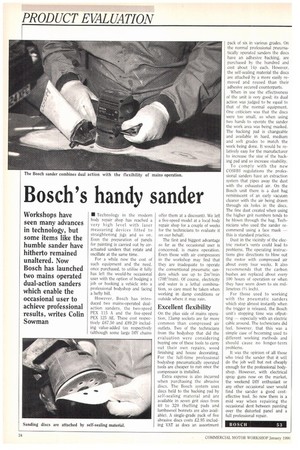Bosch's handy sander
Page 92

If you've noticed an error in this article please click here to report it so we can fix it.
Workshops have seen many advances in technology, but some items like the humble sander have hitherto remained unaltered. Now Bosch has launched two mains operated dual-action sanders which enable the occasional user to achieve professional results, writes Colin Sowman
• Technology in the modern body repair shop has reached a very high level with laser measuring devices fitted to straightening jigs and so on. Even the preparation of panels for painting is carried out by airactuated sanders that rotate and oscillate at the same time.
For a while now the cost of such equipment and the need, once purchased, to utilise it fully has left the would-be occasional user with the option of bodging a job or booking a vehicle into a professional bodyshop and facing a hefty bill.
However, Bosch has introduced two mains-operated dualaction sanders, the two-speed PEX 115 A and the five-speed PEX 125 AE. These cost respectively 167.50 and /89.20 including value-added tax respectively (although some large DIY chains offer them at a discount). We left a five-speed model at a local body repair shop for a couple of weeks for the technicians to evaluate it on our behalf.
The first and biggest advantage so far as the occasional user is concerned, is mains operation. Even those with air compressors in the workshop may find that they are inadequate to operate the conventional pneumatic sanders. which use up to 2m3/min (70ernin). Of course, electricity and water is a lethal combination, so care must be taken when working in damp conditions or outside where it may rain.
Excellent flexibility
On the plus side of mains operation, 13amp sockets are far more common than compressed air outlets. Two of the technicians from the bodyshop that did the evaluation were considering buying one of these tools to carry out their own repairs, wood finishing and house decorating. For the full-time professional bodyshop pneumatically operated tools are cheaper to run once the compressor is installed.
Extra expense is also incurred when purchasing the abrasive discs. The Bosch system uses discs held to the backing pad by self-sealing material and are available in seven grit sizes from 40 to 320 {buffing pads and lambswool bonnets are also available). A single-grade pack of five abrasive discs costs /2.95 including VAT as does an assortment pack of six in various grades. On the normal professional pneumatically operated sanders the discs have an adhesive backing, are purchased by the hundred and cost about 14p each. However, the self-sealing material the discs are attached by a more easily removed and reused than their adhesive secured counterparts.
When in use the effectiveness of the unit is very good; its dual action was judged to be equal to that of the normal equipment. One criticism was that the discs were too small, so when using two hands to operate the sander the work area was being masked. The backing pad is changeable and available in hard, medium and soft grades to match the work being done. It would he relatively easy for the manufacturer to increase the size of the backing pad and so increase visability.
To comply with the new COSH!' regulations the professional sanders have an extraction system that pipes away the dust with the exhausted air. On the Bosch unit there is a dust hag reminiscent of an early vacuum cleaner with the air being drawn through six holes in the discs. The fine dust created when using the higher grit numbers tends to he blown through the hag. Technicians who used the sander recommend using a face mask — this is standard practice.
Dust in the vicinity of the electric motor's vents could lead to problems. The operating instructions give directions to blow out the motor with compressed air about every four weeks. It also recommends that the carbon bushes are replaced about every 100 hours of operation or when they have worn down to six millimetres (Vs inch).
For those used to working with the pneumatic sanders which stop almost instantly when the trigger is released, the Bosch unit's stopping time was offputting — especially with an electric cable around. The technicians did feel, however, that this was a simple case of becoming used to different working methods and should cause no longer-term problems.
It was the opinion of all those who tried the sander that it will do the job well but not cheaply enough for the professional bodyshop. However, with electrical spray guns now on the market, the weekend DIY enthusiast or any other occasional user would find the sander a good costeffective tool. So now there is a mid way when repairing the occasional dent between painting over the distorted panel and a full professional repair.








































































































